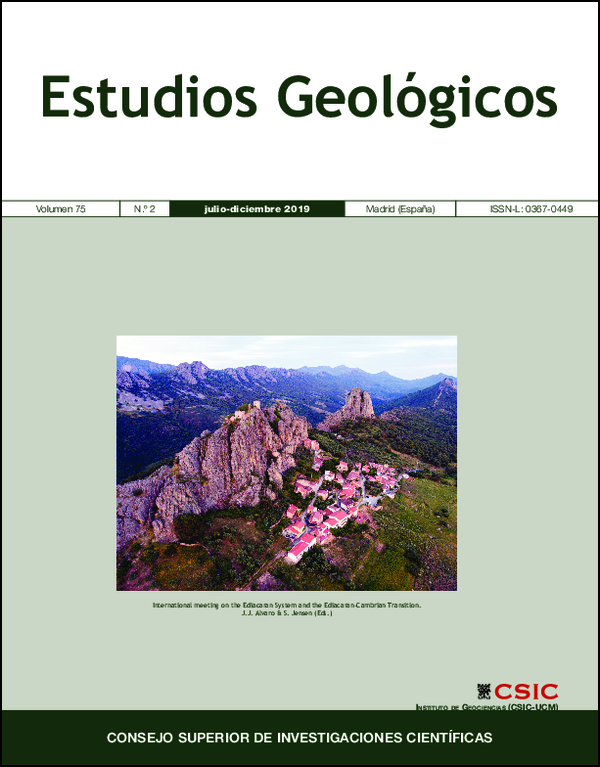The ecology of Dickinsonia on tidal flats
DOI:
https://doi.org/10.3989/egeol.43587.571Keywords:
Dickinsonia, Tidal-flat, Central Urals, Ediacaran, RussiaAbstract
Specimens of Dickinsonia from the Central Urals are characterised by clear bilateral symmetry. Taking into account observations from Australian specimens, we consider that the so called ‘glide reflection symmetry’ in these fossils is a taphonomic phenomenon. The size frequency distribution plot shows the predominance of smaller individuals in the studied population of Dickinsonia from the Central Urals. Assuming that the age of an individual is manifested in the body size, there is a significant predominance of juvenile individuals in the population. Three possible scenarios can be envisaged: (i) the population has a large number of juvenile individuals as the result of high survivorship rate in the intertidal zone; (ii) the population teems with juvenile forms because it is buried immediately after hatching; (iii) assuming that Dickinsonia was an actively motile organisms, that abundance of juvenile individuals could be explained by their inability to escape burial (although it is difficult to imagine that some of the mature individuals are buried with signs of escape behaviour); and (iv) the population could be interpreted as a fossilised ‘nesting ground’ for Dickinsonia in the intertidal zone where juvenile forms underwent maturation before migrating back to the subtidal zone. The study population can be characterised as expanding or stable; therefore, the intertidal setting can be described as favourable for these organisms.
Downloads
References
Bobkov, N.I.; Kolesnikov, A.V.; Maslov, A.V. & Grazhdankin, D.V. (2019). The occurrence of Dickinsonia in non-marine facies. Estudios Geológicos, 75(2): e096. https://doi.org/10.3989/egeol.43587.551
Buss, L.W. & Seilacher, A. (1994). The Phylum Vendobionta: a sister group of the Eumetazoa. Paleobiology, 20: 1-4. https://doi.org/10.1017/S0094837300011088
Dzik, J. (2015). Zoologia: Ró?norodno?? i pokrewie?stwa zwierz?t. PWN, Warszawa, 252 pp. https://doi.org/10.31338/uw.9788323519263
Evans, S.D.; Droser, M.L. & Gehling, J.G. (2017). Highly regulated growth and development of the Ediacara macrofossil Dickinsonia costata. PLoS One, 12: e0176874. https://doi.org/10.1371/journal.pone.0176874 PMid:28520741 PMCid:PMC5435172
Fedonkin, M.A. (1981). White Sea biota of Vendian. Precambrian non-skeletal fauna of the Russian Platform North. Nauka, Moscow, 100 pp.
Fraley, C.; & Raftery, A. E. (2006). MCLUST version 3: an R package for normal mixture modeling and model-based clustering. Washington University Seattle Dept. of Statistics. https://doi.org/10.21236/ADA456562
Fraley, C.; & Raftery, A. E. (2007). Bayesian regularization for normal mixture estimation and model-based clustering. Journal of Classification, 24: 155-188. https://doi.org/10.1007/s00357-007-0004-5
Glaessner, M.F. & Wade, M. (1996). The late Precambrian fossils from Ediacara, South Australia. Palaeontology, 9: 599-628.
Gold, D.A.; Runnegar, B.; Gehling, J.G. & Jacobs, D.K. (2015). Ancestral state reconstruction of ontogeny supports a bilaterian affinity for Dickinsonia. Evolution & Development, 17: 315-324. https://doi.org/10.1111/ede.12168 PMid:26492825
Reid, L.M.; García-Bellido, D.C. & Gehling, J.G. (2018). An Ediacaran opportunist? Characteristics of a juvenile Dickinsonia costata population from Crisp Gorge, South Australia. Journal of Paleontology, 92: 313-322. https://doi.org/10.1017/jpa.2017.142
Retallack, G.J. (2007). Growth, decay and burial compaction of Dickinsonia, an iconic Ediacaran fossil. Alcheringa, 31: 215-240. https://doi.org/10.1080/03115510701484705
Seilacher, A.; Grazhdankin, D. & Legouta, A. (2003). Ediacaran biota: The dawn of animal life in the shadow of giant protists. Paleontological Research, 7: 43-54. https://doi.org/10.2517/prpsj.7.43
Sperling, E.A. & Vinther, J. (2008). A placozoan affinity for Dickinsonia and the evolution of late Proterozoic metazoan feeding modes. Evolution & Development, 12: 201-209. https://doi.org/10.1111/j.1525-142X.2010.00404.x PMid:20433459
Sprigg, R.C. (1947). Early Cambrian (?) jellyfishes from the Flinders Ranges, South Australia. Transactions of the Royal Society of South Australia, 71: 212-224.
Published
How to Cite
Issue
Section
License
Copyright (c) 2019 Consejo Superior de Investigaciones Científicas (CSIC)

This work is licensed under a Creative Commons Attribution 4.0 International License.
© CSIC. Manuscripts published in both the print and online versions of this journal are the property of the Consejo Superior de Investigaciones Científicas, and quoting this source is a requirement for any partial or full reproduction.
All contents of this electronic edition, except where otherwise noted, are distributed under a Creative Commons Attribution 4.0 International (CC BY 4.0) licence. You may read the basic information and the legal text of the licence. The indication of the CC BY 4.0 licence must be expressly stated in this way when necessary.
Self-archiving in repositories, personal webpages or similar, of any version other than the final version of the work produced by the publisher, is not allowed.















